
27 December 2003
Well, the Webcam isn't all that great for Saturn. Here I have 100 frames carefully aligned, 2x resampled (to make them bigger and easier to align) and then stacked & laplace sharpened in Keith's Image Stacker. Can't even see the Cassini Division. Well, it was good to do the comparison. Taken 10:16pm PST. It's possible I was somewhat out of focus, but I don't really think that was it. The seeing was about as good tonight as it was last night. Part of the problem may be that the Webcam isn't nearly as light sensitive as the Canon PowerShot G3, and that you can't set the shutter for long exposures.

And poor Mars is so small and nondescript. I combined 100 frames below, but didn't sharpen it (as any sharpening just made it look worse).

Mars recedes
26 December 2003
Tried a little harder last night to get a clear picture of Saturn, and was rewarded for my efforts. These are my best Saturn images yet. I'll try the webcam next and see what happens when I stack a hundred or so frames together. The large picture is 24 frames from my Canon PowerShot G3, stacked & sharpened with Keith's Image Stacker, then brightened and reduced in Adobe Photoshop. The one below that is a composite that I took at a lower resolution setting.
26mm Televue Plossl with 2.5x Televue Barlow. Canon PowerShot G3 partially zoomed
24 frames, aligned, stacked & sharpened in Keith's Image Stacker. Brightened & cropped in Photoshop 7.0.
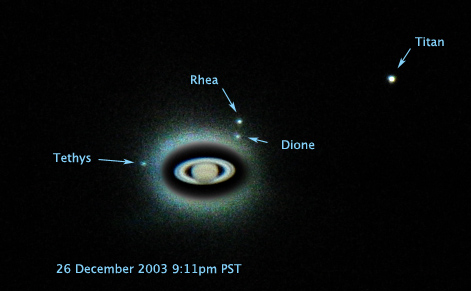
Saturn image is a composite of 25 photos aligned, stacked & sharpened in Keith's Image Stacker. Moons are a composite of 3 frames 10 or 15 seconds each. Composited in Photoshop 7.0.
25 December 2003
I went outside to see Mars today and to send happy thoughts towards Beagle 2 whose signal we still have not heard. Mars looks so cold and distant now. I didn't have the heart to take a picture of it; it would have been a tiny reddish blob with no details. So, to cheer myself up, I turned towards Saturn. Ah! Send happy thoughts to Cassini! Saturn is beautiful and I got an unexpected surprise when I connected my Canon PowerShot G3 to the scope and took a 5-second exposure. Moons! Look at all the moons! This image is a composite: first I combined three five-second exposures to highlight the moons (in that picture, Saturn is a huge white smear with no details). Then I combined 9 frames at 1/2 second each using a 2.5x barlow and adjusted its size to overlay Saturn in the overexposed first image. What I got is much better than what I saw through the scope, as I could only see Saturn and Titan without the aid of the camera.
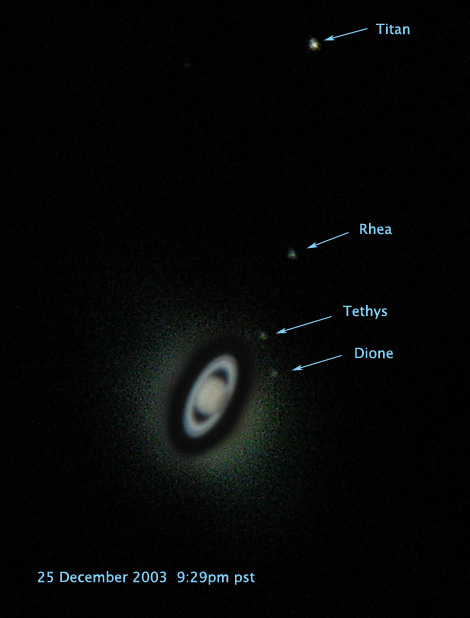
Composite of two images: Three five-second exposures to highlight the moons, nine 1/2-second exposures to highlight Saturn details. The five-second exposures taken through a 26mm Televue Plossl. 1/2-second exposures taken with same Plossl, but added a Televue 2.5x barlow. Saturn moon and Saturn images were aligned, stacked and sharpened with Keith's Image Stacker. I used Photoshop to overlay the good Saturn over the too-bright Saturn. The oval selection tool with a "feathering" of 10pixels makes it blend nicely over the first image. You can see the brightness from the underlying Saturn as a glow around the planet. Text and arrows added with Photoshop. I have also posted a raw frame of Saturn and its moons, including a star on the far left.
25 October 2003
Mars is starting to run away...
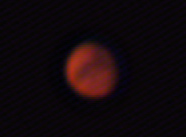
200 frames aligned, stacked, laplace sharpened 12:55am PDT 10/25/03
12 & 13 September 2003
These two images are from the beginning and the ending of a session where I had both scopes out. It was amazing to see another world spin on its axis as the night went by. My Celestron page links to an animated gif if you want to actually watch it spin.
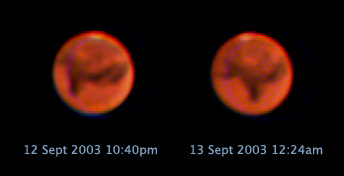
251 frames each, aligned, stacked, laplace sharpened.
6 September 2003
I finally got a chance to directly compare my two main telescopes. I had been getting some disappointing pictures out of the Celestron, so I wanted to see if it was the scope, or just bad seeing on those particular nights. I played with the Celestron a bit and adjusted the collimation slightly. That seemed to help. Then I took both out and within about 3 minutes of each other, took several movies of Mars from which the two pictures below were generated. My conclusion: both are great scopes and I love them dearly. The Celestron can really pull in the light (I had to lower the brightness on the webcam and it's still brighter than the ETX). But the surprise was how great the ETX is. Since it is much smaller and more portable, it gets a lot more use. I'm pleased that such great quality can come from such a small telescope.
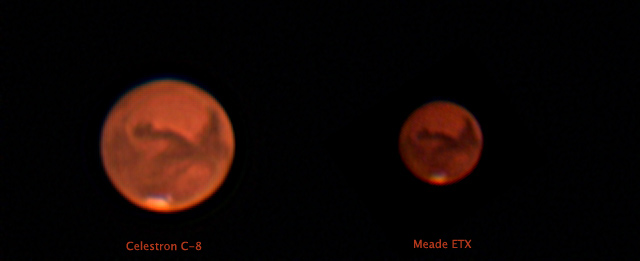
Celestron C-8 vs. the Meade ETX 90
11:30pm PDT. Moon about half full, some haze in the sky. 100 frames for each image, aligned & stacked, dark frame subtracted, laplace sharpened in Keith's Image Stacker. I have a version with 304 frames stacked on my Celestron page.
1 September 2003
I love this little scope. Last night was clear and warm and I was awake at 1am, so I decided to see how the ETX could do compared to my 8" Celestron. I'm very happy with the results. I didn't think I'd be able to get this much detail out of this telescope (although, looking at Mike Weasner's ETX site I knew it was a theoretical possibility). The south polar cap is bright and clear. I believe Mare Erythraeum is the large dark patch in the center, with Sinus Meridiani to it's upper left (at 10 o'clock). At the top at 1 o'clock would be Mare Acidalium. Click for a larger view.
1:03am PDT 1 September2003. 2.5x Tele Vue barlow
200 frames from Fire-I webcam stacked; dark frame subtracted.
Laplace Pyramid Sharpened in Keith's Image Stacker.
Reduced to 50% in Adobe Photoshop (click for the actual size image).
South is down, at 7 o'clock. Mirror image.
14 August 2003
I did a sample of a couple stars around August 8 and was reallly disappointed with the optics in my poor old Meade ETX. So on August 14, I took it entirely apart for the first time. The central tube that I thought was simply to block light reflections also acts as a stabilizer for the primary mirror when focusing. And it was loose. I tightened it up and put it all back together, a little worried that I'd knocked it out of collimation. When I took it out, I was really happy to see that not only was it still collimated, but I could once again focus back and forth without the object moving out of the view! In fact, I think the collimation now is better than it's been in a long time. Here is my first picture of Mars taken with the ETX (my first ever picture of Mars was with the Celestron 8" 5 nights before). I think these are better, which means I need to fiddle with the Celestron some more, since it should be the more capable instrument.
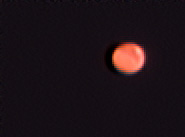
I also experimented with the 2.5x Barlow. It was much harder to keep Mars in view, but I got some nice additional detail. I played some with the Fire-i webcam's settings in Image DV and discovered that setting the sharpness higher on the webcam is useful. The image below was made from 100 frames. I subtracted a dark frame (made from stacking about 50 frames with the lens cap on) and stacked them in Keith's Image Stacker. Then I applied an unsharp mask to draw out detail. I do essentially the same thing on all images (although I don't always do a dark frame subtraction). Oh, and in Photoshop I shrunk this image down, because I thought the full-sized one didn't look quite as good. South is up, at about 2 O'clock.
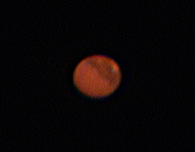
9 March 2003
Today instead of little movies, I took several snapshots at high resolution. Then I used Photoshop to combine seven of them into this single image. I finally got the clock drive almost perfectly set so I didn't have to keep realigning things to get Jupiter back in the frame. Even though the sky was still hazy and I didn't get a chance to try Saturn, the evening was a success. This is my best image of Jupiter yet.
8 March 2003
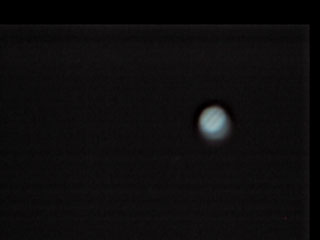
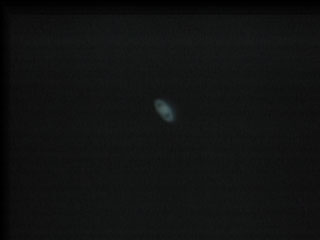
This time I was more careful, but the sky was a little less forgiving. There was a haze that gives Jupiter that extra glow (at least I hope it was the haze and not something about my optics). I had the ETX on the telescope mount with the clock drive and I used a Barlow lens to get better magnification. And I put the Canon PowerShot G1 on the Scopetronix mount-thingy. Then I took little movies and hand picked the best frames to combine about thirty of them in Keith's Image Stacker to produce these images of Jupiter and Saturn. Looking back at my pictures below, I guess these are about the best I've ever done. It's just that there are so many people out there with Meade ETX telescopes doing amazing things, that it makes these seem somewhat mediocre.
1 March 2003
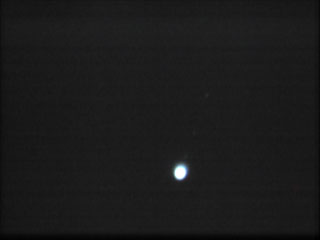
A relatively bad shot of Jupiter and three moons (moons are at 1 o'clock; the fourth moon is invisible at 7 o'clock). What's great about the picture is that it was taken spur of the moment as a quick test of a program called Keith's Image Stacker. This Mac OS X application lets you easily combine multiple (bad) images to create a single composite (good) image. Since I was unsteadily holding a digital camera over the eyepiece as Jupiter wandered about in the field of view, the above shot is quite amazing. Click on the image above to see what one of the single frames looked like. Keith's Image Stacker lets you align all the frames, throw out bad frames, then combine them into a single image. I hope sometime soon to be able to get out and try again, this time with the ScopeTronix adapter and some more patience.
28 December 2000 - Cold outside (for California) and a bit cloudy. The new moon had already set. These are my first attempts with my Canon PowerShot G1. I used the ScopeTronix adapter again. Aligning everything just right was a pain. For Jupiter I played with an unsharp mask in Adobe Photoshop. For the unretouched version of Jupiter, click on the image (Jupiter is a composite of two images). Unfortunately, the planets didn't come out as well as my PowerShot S10 images below. I'll need to play with settings some more (or else tonight was too hazy). I didn't expose Jupiter long enough.
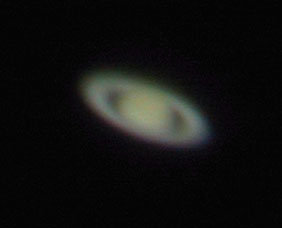 |
15 October 2000 - Finally a night free to use the ETX, PowerShot camera and mount. It was getting hazy, and the just-past-full moon was awfully bright near Saturn, but the pictures turned out great! These are composites of two or three images taken in succession, unsharp-masked in Adobe Photoshop LE, and then doubled in size. If you want to see the original sizes, click on the pictures below.
|
|
|

The above pictures are three separate attempts at capturing the transit of Mercury across the Sun on November 15, 1999. They were taken through my Meade ETX with an Orion solar filter, 26MM Televue Plossl and a Hi8 Videocamera. I now have my ETX mounted on an Orion SkyView Deluxe equatorial mount with a clock drive. This leads to much better vieweing at high magnifications than I was getting with a straight tripod. Video capture was done on a PC with ZipShot parallel capture device, then moved over to my Macintosh for processing. I took three successive captures and combined them in Adobe PhotoDeluxe (a wimpy version of Photoshop) using layers and the "overlay" feature. I eyeballed the correct placement of each of the three layers (actually, the first of these is four layers) turning visibility of the layer on and off until they fit as closely as I could make them.
The Equipment I used:
I never expected the images to come out as good as they did, and I have ideas for improving them somewhat. If you already have a telescope, but no videocamera, see if someone will loan you theirs. Even if you don't have a computer that takes video-in, you can save to videotape and get some impressive pictures. In fact, the moving images on tape look better than most of these stills, since your eye does some pretty fancy digital processing on the images.
Jupiter. Also taken with a videocamera, but this is a single frame
grabbed from the camera. I played with brightness and contrast in
Photoshop.
Jupiter, lower power. Combined three separate images, none of which
showed the moons very well. There are three moons close together at
the 8 O'clock position, and one way up to the right at 2 O'clock.
Jupiter from 5 images combined. I let the videocamera run as Jupiter
wandered across my field of view, then took five still frames and
combined them. Blurry but colorful.
Saturn, from three images combined. I lost a little detail, but
gained a little color.
Saturn using just a single frame from the videocamera.